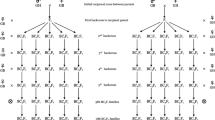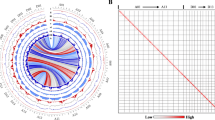Abstract
Cotton is unusual among major crop plants in that two cross-fertile species are widely cultivated for a common economic product, fiber. Both historical evidence and classical genetic studies suggest that many improved forms of Gossypium barbadense (“Sea Island”, “Egyptian”, and “Pima” cottons) may include chromatin derived from G. hirsutum. Using 106 restriction fragment length polymorphism (RFLP) loci well distributed across the cotton genome, we revealed the amount and genomic distribution of G. hirsutum chromatin in 54 G. barbadense collections from around the world. The average G. barbadense collection was comprised of 8.9% alleles apparently derived from G. hirsutum. Pima cultivars (7.3 %) had fewer G. hirsutum alleles than Sea Island (9.0%) or Egyptian (9.6%) cultivars. G. hirsutum alleles were not randomly distributed, as 57.5% of the total introgression observed was accounted for by five specific chromosomal regions that span less than 10% of the genome. The average length of an introgressed chromosome segment was ⩾ 12.9 cM. Overlap of introgressed chromatin in different breeding programs hints that retention of these G. hirsutum chromosomal segments may impart a selective advantage to G. barbadense genotypes. Although cluster analysis generally grouped germ plasm from common classes and/or breeding programs together, no 2 genotypes were identical — thus differences in the length and repertoire of introgressed chromosome segments also permit DNA fingerprinting of G. barbadense cultivars.
Similar content being viewed by others
References
Bryan WE (1955) Prospects for Pima S-1 cotton. Progr Agric Ariz 7:6
Brown HB, Ware JO (1958) Cotton, 3rd edn. McGraw-Hill, New York
Brubaker CL, Koontz JA, Wendel JF (1993) Bidirectional cytoplasmic and nuclear introgression in the New World cottons, Gossypium barbadense and G. hirsutum (Malvaceae). Am J Bot 80:1203–1208
Feaster CV, Turcotte E (1962) Genetic basis for varietal improvement of Pima cottons. USDA-ARS 34-31
Grant V (1981) Plant speciation. Columbia University Press, New York, pp 234
Hanson WD (1959b) The breakup of initial linkage blocks under selected mating systems. Genetics 44:857–868
Hutchinson JB (1959) The application of genetics to cotton improvement. Cambridge University Press, London
Hutchison JB, Manning HL (1945) The Sea Island cottons. Emp J Exp Agric 13:80–92
Jena KK, Khush GS, Kochert G (1992) RFLP analysis of rice (Oryza sativa L.) introgression lines. Theor Appl Genet 83: 1027–1034
Jenkins JG (1953) Coastland — a new long-staple cotton for the Southeast. Ga Coastal Plain Exp Stn Bull 53
Kearney TH (1943) Egyptian-type cottons: their origin and characteristics. Report Division Cotton and other Fiber Crops and Diseases, USDA Mimeo
Meredith WR (1991) Contribution of plant introductions to cotton improvement. In: Shands HL, Wiesner (eds) Use of plant introductions in cultivar development, part I. Crop Sci Soc Am, Madison, Wis., pp 127–146
Niles GA, Feaster CV (1984) Breeding. In: Kohel RJ, Lewis CF (eds) Cotton Agron Monogr 24, ASA, Madison, Wis., pp 201–231
Osborn TC, Alexander DC, Fobes JF (1987) Identification of restriction fragment length polymorphisms linked to genes controlling soluble solids content in tomato fruit. Theor Appl Genet 73:350–356
Paterson AH, Brubaker CL, Wendel JF (1993) A rapid method for extraction of cotton (Gossypium spp.) genomic DNA suitable for RFLP and PCR analysis. Plant Mol Biol Rep 11:122–127
Percy RG, Wendel JF (1990) Allozyme evidence for the origin and diversification of Gossypium barbadense L. Theor Appl Genet 79:529–542
Reinisch AJ, Dong D, Brubaker CL, Stelly DM, Wendel JF, Paterson AH (1994) A detailed RFLP map of cotton, G. thirsutum x G. barbadense: chromosome organization and evolution in a disomic polyploid genome. Genetics 138:829–847
Rieseberg LH, Solus DE, Palmer JD (1988) A molecular reexamination of introgression between Hellanthus annuus and H. bolanderi (compositae). Evolution 42:227–238
Rogers JS (1972) Measurements of genetic similarity and genetic distance. (Studies in Genetics VII). University of Texas Publication 7213, Austin, Tex.
Sarfatti M, Katan J, Fluhr R, Zamir D (1989) An RFLP marker in tomato linked to the Fusarium oxysporum resistance gene 12. Theor Appl Genet 78:755–759
SAS Institute (1989) SAS/STAT users guide, version 6, 4th edn., vol 1. SAS Institute, Cary, N.C.
Stebbins GL (1969) The significance of hybridization for plant taxonomy and evolution. Taxon 18:26–35
Stephens SG (1974) The use of two polymorphic systems, nectary fringe hairs and corky alleles, as indicators of phylogenetic relationships in New World cottons. Biogeotropica 6:194–201
Stephens SG (1976) The origin of Sea Island cotton. Agric History 50:391–399
Tanksley SD, Hewitt J (1988) Use of molecular markers in breeding for soluble solids content in tomato-a re-examination. Theor Appl Genet 75:811–823
USDA-ARS (1987) The national collection of Gossypium germplasm. South Coop Ser Bull 321
Young ND, Zamir D, Ganal M, Tanksley SD (1988) Use of isogenic lines and simultaneous probing to identify DNA markers tightly linked to the TM2a gene in tomato. Genetics 120:579–585
Author information
Authors and Affiliations
Additional information
Communicated by A. L. Kahler
Rights and permissions
About this article
Cite this article
Wang, GL., Dong, JM. & Paterson, A.H. The distribution of Gossypium hirsutum chromatin in G. barbadense germ plasm: molecular analysis of introgressive plant breeding. Theoret. Appl. Genetics 91, 1153–1161 (1995). https://doi.org/10.1007/BF00223934
Received:
Accepted:
Issue Date:
DOI: https://doi.org/10.1007/BF00223934




